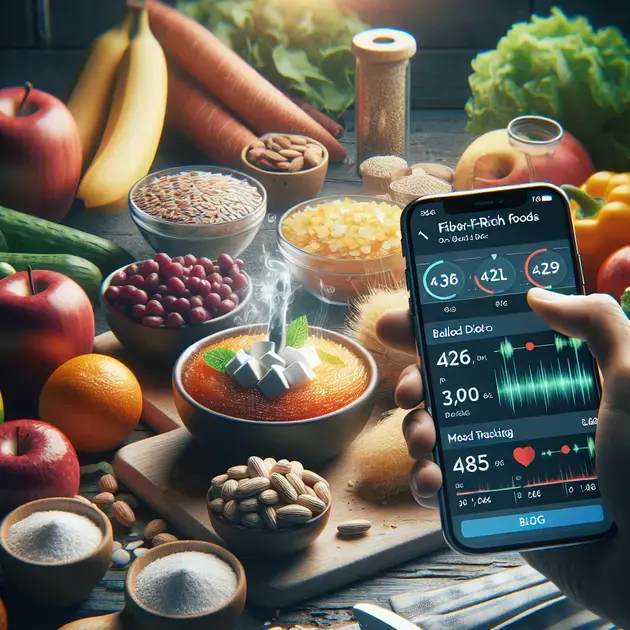Maintaining optimal blood sugar levels after eating is crucial for overall health and well-being. As recent studies highlight, consistently high post-meal glucose levels can lead to long-term health complications like type 2 diabetes and cardiovascular diseases. Knowing what to aim for in terms of blood sugar levels can empower individuals to make healthier dietary choices and manage their health more effectively.
To understand the importance of monitoring and controlling blood sugar, it’s essential to recognize the impact of different foods on blood glucose levels. Foods high in refined sugars and carbohydrates typically cause a rapid increase, whereas high-fiber, whole foods tend to result in a slower rise. Balancing your diet and knowing the glycemic impact of foods can help in maintaining glucose levels within a safe range, reducing the risk of health issues and enhancing energy and mood stability throughout the day.

Understanding the Glycemic Index Scale for Optimal Blood Sugar Control
Understanding the Glycemic Index (GI) scale is crucial for optimal blood sugar control. The GI ranks carbohydrates based on how they affect blood glucose levels. Low GI foods (55 or less) are digested more slowly, causing a gradual rise in blood sugar. High GI foods (70 or higher) are quickly digested, leading to spikes in blood sugar levels. To know the GI of foods, you can refer to reputable sources like the official website of the Glycemic Index Foundation or use apps like MyFitnessPal, which provides GI information for various foods.
One practical step to utilize the GI scale is to prioritize low GI foods in your diet, such as whole grains, legumes, and non-starchy vegetables. These foods help maintain stable blood sugar levels and provide sustained energy throughout the day. Additionally, using meal planning apps like Yummly can assist in creating balanced meals with a focus on low GI ingredients, promoting better blood sugar management.
Tracking your food intake and monitoring its impact on your blood sugar can also be simplified by using glucose monitoring apps like mySugr. These apps not only track your meals but also provide insights into how different foods affect your blood glucose levels, helping you make more informed dietary choices for optimal blood sugar control.
By understanding and applying the principles of the GI scale in your diet, you can effectively manage your blood sugar levels, reducing the risk of fluctuations and long-term health complications associated with high blood sugar.
The Role of Fiber in Regulating Post-Meal Glucose Levels
Fiber plays a significant role in regulating post-meal glucose levels due to its ability to slow down digestion and absorption of carbohydrates. Soluble fiber, found in foods like oats, legumes, and fruits, forms a gel-like substance in the gut, delaying the release of sugars into the bloodstream. Insoluble fiber, present in vegetables and whole grains, adds bulk to the stool, promoting a gradual rise in blood sugar levels post-meal.
To increase your fiber intake and stabilize post-meal glucose levels, consider incorporating fiber-rich foods into your meals. Websites like Healthline offer detailed guides on high-fiber foods and their benefits for blood sugar control. You can also use nutrition tracking apps such as Cronometer, which not only monitor your fiber intake but also provide personalized recommendations to meet your dietary fiber goals.
Another way to boost your fiber consumption is by including snacks like nuts, seeds, and fiber bars in your daily routine. Apps like ShopWell can assist in identifying high-fiber snack options while grocery shopping, making it easier to choose snacks that support healthy blood sugar levels.
By understanding the role of fiber in the regulation of post-meal glucose levels and making conscious efforts to increase fiber-rich foods in your diet, you can promote better blood sugar control and overall health.
Practical Tips for Balancing Your Diet to Maintain Healthy Blood Sugar Levels
Maintaining healthy blood sugar levels requires a balanced diet that incorporates a variety of nutrients and minimizes the consumption of high GI foods. Start by creating a meal plan that includes a combination of lean proteins, healthy fats, and complex carbohydrates. Websites like EatingWell offer meal planning tips and recipes tailored for blood sugar management.
When grocery shopping, utilize apps like Fooducate to scan product barcodes and receive instant nutritional information, including sugar content and GI value. This can help you make informed choices and select foods that align with your goal of maintaining healthy blood sugar levels.
Incorporating regular physical activity into your routine is another essential aspect of blood sugar control. Fitness apps like MyFitnessPal not only track your exercise but also allow you to log your meals and monitor their impact on your blood glucose levels, providing a holistic approach to managing your health.
Hydration is also key in supporting healthy blood sugar levels. Apps like WaterMinder can help you track your daily water intake and remind you to stay hydrated throughout the day, contributing to overall well-being and blood sugar regulation.
By following these practical tips and utilizing technology to support your efforts, you can effectively balance your diet, maintain healthy blood sugar levels, and improve your overall quality of life.

**
The Importance of Timing Your Meals for Stable Blood Sugar Levels
**
Timing your meals plays a crucial role in maintaining stable blood sugar levels throughout the day. Eating at consistent intervals helps regulate your body’s glucose levels, preventing spikes and crashes that can negatively impact your health. By spacing out your meals evenly, you provide your body with a steady source of energy, ensuring that your blood sugar remains within a healthy range.
Studies have shown that consuming meals at the same time each day can improve insulin sensitivity, which is essential for proper blood sugar regulation. When your body becomes more sensitive to insulin, it can more effectively remove glucose from the bloodstream, preventing it from accumulating to dangerous levels. This can reduce your risk of developing conditions like diabetes and metabolic syndrome.
In addition to consistency, the quality of your meals also plays a significant role in blood sugar management. Choosing nutritious, balanced meals that are rich in fiber, protein, and healthy fats can help slow down the release of glucose into your bloodstream, preventing sudden spikes. By avoiding sugary, processed foods and opting for whole foods instead, you can support stable blood sugar levels throughout the day.
Furthermore, paying attention to the timing of your meals can help optimize your body’s natural circadian rhythm, which influences various aspects of your health, including metabolism and hormone regulation. Eating in alignment with your body’s internal clock can enhance digestive function and nutrient absorption, promoting overall well-being and blood sugar stability.
In conclusion, the importance of timing your meals for stable blood sugar levels cannot be overstated. By eating at consistent intervals, choosing nutrient-dense foods, and aligning your meals with your body’s circadian rhythm, you can support optimal blood sugar regulation and improve your overall health.
**
How Different Types of Exercise Impact Post-Meal Glucose Levels
**
Exercise plays a significant role in regulating post-meal glucose levels, with different types of physical activity influencing blood sugar management in unique ways. Aerobic exercises, such as running, cycling, and swimming, are known to increase insulin sensitivity, allowing your body to more effectively utilize glucose for energy. This can help lower post-meal blood sugar levels and improve overall glycemic control.
Strength training exercises, on the other hand, primarily focus on building muscle mass, which plays a key role in glucose metabolism. By increasing muscle mass through activities like weightlifting and resistance training, you can enhance your body’s ability to store and use glucose, reducing the risk of hyperglycemia after meals. Strength training can also have long-lasting effects on post-meal glucose levels by boosting your resting metabolic rate and promoting continuous energy expenditure.
Furthermore, incorporating flexibility exercises, such as yoga and stretching, into your routine can have additional benefits for blood sugar regulation. These activities help reduce stress levels, which can impact insulin production and sensitivity. By promoting relaxation and stress relief, flexibility exercises can contribute to more stable post-meal glucose levels and improved overall metabolic health.
It’s essential to note that the combination of different types of exercise, including aerobic, strength training, and flexibility exercises, can offer comprehensive benefits for blood sugar management. By creating a diverse workout routine that incorporates various forms of physical activity, you can optimize your post-meal glucose levels and support overall metabolic health.
**
Exploring the Connection Between Stress and Blood Sugar Regulation
**
The relationship between stress and blood sugar regulation is complex and multifaceted, with chronic stress being a significant factor in the development of metabolic disorders like diabetes. When you experience stress, your body releases hormones like cortisol and adrenaline, which can lead to increased blood sugar levels as part of the “fight or flight” response. Over time, persistent stress can disrupt your body’s natural ability to regulate glucose, contributing to insulin resistance and elevated blood sugar levels.
Furthermore, stress can also impact your behaviors and lifestyle choices, such as poor dietary habits and lack of physical activity, which can further exacerbate blood sugar imbalances. Emotional eating, where individuals consume high-sugar, high-fat foods to cope with stress, can lead to unhealthy spikes in blood sugar and contribute to long-term metabolic issues.
Addressing stress through various relaxation techniques, such as mindfulness meditation, deep breathing exercises, and yoga, can help improve blood sugar regulation and reduce the risk of metabolic disorders. By managing stress effectively, you can support healthy cortisol levels, optimize insulin sensitivity, and promote stable blood sugar levels throughout the day.
Exploring the connection between stress and blood sugar regulation highlights the importance of adopting holistic approaches to health that address both physical and emotional well-being. By prioritizing stress management techniques and creating a supportive environment for overall wellness, you can positively impact your blood sugar levels and reduce the risk of developing metabolic conditions associated with chronic stress.
Conclusion
Ensuring that you time your meals appropriately is vital for maintaining stable blood sugar levels and overall health. Consistency in meal timing helps in regulating glucose levels, thus preventing harmful spikes and crashes that can have adverse effects on your well-being. By spacing out your meals evenly, you provide your body with a constant source of energy, keeping your blood sugar at a healthy level.
Studies indicate that consuming meals at consistent times daily can enhance insulin sensitivity, a key factor in proper blood sugar regulation. Improved insulin sensitivity allows your body to efficiently remove glucose from the bloodstream, reducing the risk of conditions like diabetes and metabolic syndrome. Additionally, the quality of your meals matters significantly in managing blood sugar levels. Opting for nutrient-rich foods rich in fiber, protein, and healthy fats slows down glucose release, preventing sudden spikes and supporting stable blood sugar levels.
Moreover, paying attention to meal timing can optimize your body’s circadian rhythm, impacting various aspects of health, including metabolism and hormone regulation. Aligning your meals with your internal body clock can boost digestive function, aid in nutrient absorption, and promote overall well-being and blood sugar stability. In conclusion, the significance of timing your meals for stable blood sugar levels cannot be emphasized enough. By maintaining a consistent meal schedule, selecting nourishing foods, and syncing your meals with your body’s circadian rhythm, you can promote optimal blood sugar control and enhance your overall health.
